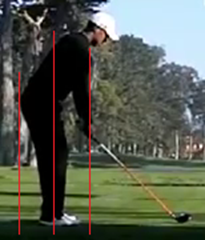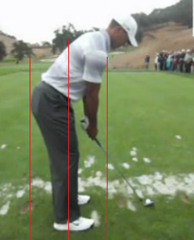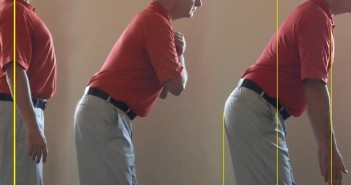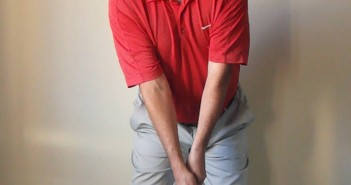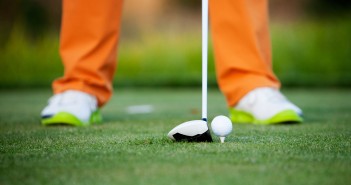Achieving the proper spine angle and position, for your own body, at address is vital for a successful golf swing. It is a key factor in enabling you to turn efficiently, and to swing powerfully and consistently, while protecting your back and avoiding back pain and injury.
The proper spine position will place your spine, and its supporting muscles, in the best position for an efficient and stable turn throughout the golf swing, able to safely support and protect your back as enormous centrifugal forces are generated through impact, while remaining centred and balanced throughout the swing.
Proper spine angle is also vital in achieving proper balance throughout the golf swing, helping to provide a solid foundation and a stable axis for rotation.
Straight Back
Your spine, or vertebral column, consists of 24 articulating vertebrae and 9 fused vertebrae, giving 26 movable components within your spine. These components are linked by a series of mobile joints, and sandwiched between the bones in each joint is an intervertebral disc, a springy pad of tough, fibrous cartilage that compresses slightly under pressure to absorb shock and load. Strong ligaments and many sets of muscles around your spine stabilise the vertebrae and help to support and control your movements.
Your spine is not straight, each region curves naturally when in a “neutral” position. When you bend your spine away from this neutral position, for example by hunching forwards with your upper back or bending at your waist, as so many golfers do, you severely limit the amount of rotation that is possible between the vertebrae in those parts of your spine. By limiting the inter-vertebral rotation by an average of just half a degree, you limit your ability to turn your shoulders by over 12 degrees.
It’s not uncommon to see a golfer limit his shoulder turn to just 60 degrees just by bending incorrectly at address, resulting not just in considerable loss of power, but also, potentially, in severe back pain. Just adopting the proper spine position at address would enable them to easily turn their shoulders 90 to 100 degrees without discomfort.
Most golfers tend to look down at the golf ball at address, causing excessive forward bending, or flexion, of the cervical region of the spine (the neck).
Bending in the thoracic spine (mid to upper back) is one of the most common setup flaws. It causes numerous swing issues and severely limits rotational mobility.
Most golfers bend their thoracic spine as they slump or round their shoulders at address, caused by protracting their shoulder blades as they move their hands in front of their chest to take their grip. This leads to the golfer being disconnected from his core muscles, and, unless he makes significant compensations, he will be forced to use primarily his upper body to drive his movement from the top of the backswing, rather than initiating the downswing with the hips and lower body.
Thus, excessive curvature of the thoracic spine will usually result in an inefficient, over-the-top move and a slice-producing out-to-in swing path for higher handicap golfers.
With many golfers, the thoracic spine is rounded as the golfer rotates his elbows to point away from his body. It is crucial that you keep your elbows in good posture, with the fronts of your elbows (the antecubital region) facing directly forward and your palms facing each other. When in perfect posture, if you bend your elbows then your forearms will be parallel to each other and pointing directly out in front of you.
Finally, the lumbar spine (lower back). In an effort to keep their backs straight, golfers quite often excessively arch their lower back, creating lordosis. This is also a common trait in golfers because some instructors have advocated “sticking the backside out” at address. This sway back appearance is easily eliminated by engaging your abdominal muscles as part of assuming proper posture at address.
If your lumbar spine is excessively arched at address, this puts you at greater risk of lower back pain and injury. If you often feel tension or pain in your lower back after playing golf, it is most likely that you simply need to follow Golf Swing Drill 103 – Setup: Perfect Golf Spine Angle, and that will remove the discomfort.
When you adopt good posture, with a neutral spine position, and you address the golf ball correctly by hinging at the hip joints, this will cause your upper and lower back to appear flat, or straight, as your pelvis rotates (tucks) slightly relative to your spine, and your neck will be parallel to your back.
The correct way to achieve this perfect “straight back” position is by assuming correct posture and then maintaining your spine in a neutral position as you bend to address the ball — you do this by bending from the hip joints and dropping your hips back, not by bending the spine. You’ll see exactly how to achieve the perfect position, every time, next, in Golf Swing Drill 103 – Setup: Perfect Golf Spine Angle.
Be sure to maintain correct posture as you bend forwards — your chin stays up (your neck will be parallel to your back), your shoulders stay back and down, your pelvic floor is engaged, your abdominal muscles are pulled in and up correctly, your core stays connected. See Golf Swing Drill 101 – Setup: Perfect Posture and Connecting to Your Core for a refresher on this.
Perfect Golf Spine Angle and Balance
The perfect spine angle depends on your body — your build, the relative length of your arms, legs, torso, etc. — as well as on the length and lie of the golf club selected. For most golfers, perfect spine angle will typically be somewhere between 35 and 45 degrees.
The key to finding your perfect spine angle is achieving proper balance, bending from your hip sockets as you drop your hips back. You’ll see exactly how to achieve this next, in Golf Swing Drill 103 – Setup: Perfect Golf Spine Angle.
As we discussed in Golf Swing 102c – Setup: The Perfect Golf Weight Distribution and Balance, you should be balanced over the front-centre of your ankles at address, this is the natural balance point in the human body. The exact balance position will vary slightly depending on your build, but it will be somewhere between the centre of your ankle and the point where the front of the tibia (shinbone) joins the foot.
Having the weight centred over the ankles at address, rather than further forward towards the toes, enables you to balance the enormous centrifugal and inertial forces generated during the downswing. It also enables you to fully engage your glutes, providing a tremendous amount of stability and power for your golf swing.
As you address the golf ball, your knees should be flexed slightly so as to provide power and mobility while maintaining the correct balance. Your glutes and hamstrings should be activated, not your quadriceps (the front of your thighs), for power and stability. The primary role of your quadriceps is to move your lower leg away from your body (kicking), they are not designed to support your hips during the powerful rotation that is required during your golf swing — that is the role of the glutes.
You can check that you are balanced correctly by taking a photo of your address position from down the line. Draw three vertical lines — one level with back of your behind (your “tush line”); one through the front-centre of your ankles; and one through the front of your shoulders (your deltoids).
If you are properly balanced over your ankles then these three lines should be equally spaced. Halfway between your tush line and your shoulder line is your centre of balance, which should be your ankle line — see Figures 2 and 3.
If your ankle line is closer to your tush line than to your shoulder line, then your weight is too far forwards, because halfway between the tush and shoulder lines (your centre of balance) would be forwards of your ankle line. If your ankle line is closer to your shoulder line than to your tush line, then your weight is too far back.
The exact position of your own tush line will vary slightly with your spine angle, depending on your build and your golf club selection, but for most golfers it will be about 6” (15cm) behind your heels.
We will see later, in Golf Swing Drill 105 – Setup: Spine Tilt at Address, that your spine should also tilt away from the target, but don’t worry about that just yet.
Perfect Golf Knee Flex
You should also see that another vertical line could be drawn from the back-centre of your ankle joints to the back of your knees, which indicates the proper knee flex.
Too little knee flex and you won’t have enough stability, your glutes won’t be engaged, you won’t feel athletic, and you won’t be able to swing efficiently.
It is very rare that we see a student with too little knee flex, since it feels so unbalanced and weak. The more common fault, and the more dangerous one, is having too much knee flex at address.
It is imperative, to ensure your health and safety, as well as for efficient swing mechanics, that you do not have excessive knee flex in your setup.
Too much knee flex will cause you to feel tension in your quadriceps (the front of your thighs) as they are activated — we want the glutes and hamstrings to be activated instead, for much more power and stability throughout the golf swing.
Excessive knee flex will also move your primary balancing joint from your hip to your knee, placing the burden of rotational movement onto your knee joints. The knee joint is a hinge joint; its function is to allow forward and backward movement, mainly in one plane. This means that it is designed for extension and flexion only, it is not designed to rotate. Trying to rotate around your knee joint during the golf swing can cause discomfort and potential injury.
Your hip, however, is a ball-and-socket joint in which the ball-shaped head of the femur fits into the cup-like cavity of the pelvis. Of all joint structures, a ball-and-socket joint gives the widest range of movement, and is designed to allow for rotation. Given the rotational nature of the golf swing, it is imperative that your weight be centred over your ankles so that your hips can rotate efficiently during the golf swing.
Correct knee flexion will ensure that the large muscles of your hips will bear the rotational forces of the golf swing, and the proper muscles in your legs and core can be used for both power and stability.
Too much knee flexion will also encourage your weight forward onto the balls of the feet as you begin your backswing. This will cause you to engage your quadriceps throughout the swing. With your weight forward and your quadriceps engaged, you will be putting unnecessary and potentially harmful stress on your knee joint during the downswing, and you will not be able to properly engage the glutes and hip muscles necessary for stability.
You can feel this by putting all your weight over the ball of your left foot and rotating. Then, shift all your weight back over your left ankle and rotate again. You can easily feel how much strain is placed on your knee when you are on the balls of your feet.
Luckily, setting up with perfect knee flexion is simple, as we’ll see in Golf Swing Drill 103 – Setup: Perfect Golf Spine Angle.
Perfect Distance from the Golf Ball
The perfect distance from the golf ball is determined by your spine angle and the length of the golf club selected.
When you adopt the correct spine angle in good posture, with your arms relaxed and free of tension, they should and hang down naturally beneath your shoulders, with your elbows directly beneath your shoulders — see Figure 3. The fronts of your elbows (the antecubital region) will face directly forward, away from your body, and your palms will face each other. If you bent your elbows, then your forearms would be parallel to each other and pointing directly out in front of you — this is crucial for numerous reasons, as we’ll see in later articles, and it is a result of good posture (see “The Myth of Opposing Hands”, below).
When you take a golf club and address the golf ball, however, your left arm will naturally internally rotate slightly as it moves across your chest to grip the golf club. Your right arm, however, should be slightly externally rotated, so that the front of your elbow points slightly to the right, which will help to simplify your golf swing and ensure the perfect position at the top of your backswing. We’ll discuss this in Golf Swing 106 – Setup: Distance from the Golf Ball – Hand and Arm Positions. For now, just make sure that you have good posture, and your arms hang with the fronts of your elbows pointing forwards and your palms facing each other.
Note that your upper arms should hang more to the sides of your chest than in front of it, with the insides of your biceps touching the sides of your pectorals. Your shoulders should be in good posture, and you should feel connected. Your arms should be relaxed, not pressed towards each other.
The change in spine angle is only really noticeable with your driver, which we regard as a speciality shot, with which you will set up slightly differently; you will stand a little taller and your hands will be slightly higher at address — more of that in later articles.
See Figures 2 and 3, which show Tiger Woods’ address position with a driver and wedge respectively. Remember that your own perfect spine angle may differ from Tiger’s slightly, depending on your build.
Standing more upright will push your hands away from your body very slightly as your chest pushes against your upper arms (Figures 2 and 4), but even with the driver your whole grip should be behind a line drawn vertically down from your chin at address — see Figure 4.
The precise spine angle that is correct for you for each club depends on your build and body proportions, but, as a general rule of thumb, if you are in good posture, with your chin up and your neck in line with your spine, then you should bend over enough to look at the ball clearly past the bridge of your nose, and not have to look down the length of your nose to see the golf ball.
With your body in the correct position, the golf club should be addressing the ball correctly. You should never move your hands forwards or backwards, or adjust your spine angle or balance, in order to correct the position of the golf club. If you find that you are too close to, or too far from, the golf ball (you are not addressing the ball with the sweet spot of the club face), then stand up, adjust the position of your feet, and take your address position again from the beginning.
When you’re able to assume your perfect spine angle every time, after practising Golf Swing Drill 103 – Setup: Perfect Golf Spine Angle for a little while, you’ll then quickly be able to instinctively stand the correct distance from the ball the first time, every time.
It is very easy to be lazy about this, which will quickly lead to bad habits and an inconsistent golf swing. Be rigorous and strict with yourself, work through the setup drills, and check your setup position regularly with photos or video — the best players in the world check their setup at least once a week, so should you.
For more information, see Golf Swing 106 – Setup: Distance from the Golf Ball and Arm Position.
The Myth of Opposing Hands
There is a common golf instruction myth that tells you that your hands will turn in opposite directions, in towards your thighs, when your arms are relaxed and hanging under your shoulders naturally, and that, because of this, your grip should have the hands turned in a similar way — the right* hand with a weaker grip, the left hand stronger, or alternatively that you should have both hands in a very strong grip position.
If you have good posture, with your shoulder blades retracted and down, then your hands will not automatically turn in towards your thighs.
This myth is based on sheer ignorance and can’t die quick enough! Following this advice will lead to numerous swing faults and potential injury, as it places undue stress on your shoulders and right elbow.
Do not adjust your setup to compensate for poor posture, fix your posture! Good posture will benefit a lot more than just your golf swing, and the results will be significant and lasting.
Maintaining Your Spine Angle Through the Golf Swing
Once you achieve the perfect spine angle at address, maintaining it throughout the swing is crucial.
When analysed in a photo as described above, the vast majority of golfers will find that they are balanced too far forwards. As discussed in Golf Swing 102c – Setup: The Perfect Golf Weight Distribution and Balance, this is damaging for the golf swing in a number of ways, and it’s the main reason that most golfers are unable to maintain the proper spine angle throughout their swing, leading to a variety of faults and inconsistencies.
We see many golfers who, at first glance, look great at address, but complain that they are unable to maintain their spine angle through the swing. This is very often because their weight is too far forwards at address, they lack stability as they take the club back, and they lose their “connection” to the ground. In trying to stay in balance, they are unable to shift their weight correctly and their head moves towards the ball. A slight shift in balance at address has destroyed their swing before it even started. As they start back down their balance is all wrong, and they subconsciously straighten up, lifting out of their spine angle, in an attempt to create space for their arms and hands in the downswing. And when they do try and stay down on the shot, their poor balance will often lead to a horrible dose of the shanks.
Maintaining your spine angle during the golf swing will be discussed in greater detail in later articles.
If you have any questions or comments about this or other articles on Golf Loopy, please send us an email.
Next, we’ll describe exactly how you can achieve the perfect spine angle and balance at address, every time, in Golf Swing Drill 103 – Setup: Perfect Golf Spine Angle.



